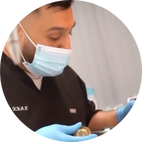Lump On Child's Gum: Get Expert Diagnosis

A lump on a child’s gum can be a cause for concern for parents, as it may indicate an underlying condition that requires medical attention. Gum lumps, also known as gum boils or parulis, can appear as swollen, painful bumps on the gums, and may be accompanied by other symptoms such as fever, bad breath, or difficulty chewing. In some cases, a lump on a child’s gum may be a sign of a more serious condition, such as an abscess or a cyst, which can lead to further complications if left untreated.
To understand the potential causes of a lump on a child’s gum, it’s essential to consider the anatomy of the mouth and the various structures that can be affected. The gums, also known as the gingiva, are the soft tissues that surround the teeth and provide a protective barrier against bacteria and other foreign particles. However, when the gums become infected or inflamed, it can lead to the formation of a lump or abscess. In children, the immune system is still developing, making them more susceptible to infections and other conditions that can affect the gums.
One of the primary causes of a lump on a child’s gum is a bacterial infection, which can occur when bacteria accumulate in the mouth and infect the gums. This can happen due to poor oral hygiene, a diet high in sugar, or other factors that contribute to the buildup of plaque and tartar on the teeth. If left untreated, a bacterial infection can lead to the formation of an abscess, which is a pocket of pus that can cause pain, swelling, and other symptoms.
Another potential cause of a lump on a child’s gum is a cyst, which is a fluid-filled sac that can form in the gums or other tissues of the mouth. Cysts can be caused by a variety of factors, including infection, trauma, or developmental abnormalities. In some cases, a cyst may be present at birth, while in other cases, it may develop later in life due to an underlying condition or injury.
In addition to bacterial infections and cysts, there are several other potential causes of a lump on a child’s gum, including:
- Trauma: A blow to the mouth or a fall can cause a lump to form on the gum, especially if the injury is severe enough to cause bleeding or swelling.
- Teething: In some cases, a lump on a child’s gum may be related to teething, especially if the child is experiencing discomfort or pain during the teething process.
- Gingival hyperplasia: This is a condition in which the gums become overgrown, leading to the formation of a lump or swelling.
- Tumor: In rare cases, a lump on a child’s gum may be a sign of a tumor, such as a benign growth or a malignant cancer.
To diagnose the cause of a lump on a child’s gum, a dentist or doctor will typically perform a physical examination, which may include:
- Visual inspection: The dentist or doctor will examine the lump and the surrounding area to look for signs of infection, inflammation, or other abnormalities.
- Palpation: The dentist or doctor may gently press on the lump to check for tenderness or pain.
- Imaging tests: In some cases, imaging tests such as X-rays or CT scans may be used to evaluate the lump and determine its cause.
- Biopsy: If the lump is suspicious or cannot be diagnosed with imaging tests, a biopsy may be performed to examine the tissue and determine its cause.
Once the cause of the lump has been diagnosed, treatment can begin. In some cases, treatment may involve:
- Antibiotics: If the lump is caused by a bacterial infection, antibiotics may be prescribed to help clear up the infection.
- Drainage: If the lump is an abscess, it may need to be drained to remove the pus and promote healing.
- Surgery: In some cases, surgery may be necessary to remove a cyst or tumor, or to repair damaged tissue.
- Good oral hygiene: Practicing good oral hygiene, including brushing and flossing regularly, can help prevent future lumps and promote overall oral health.
What are the symptoms of a lump on a child's gum?
+Symptoms of a lump on a child's gum may include pain, swelling, redness, and difficulty chewing. In some cases, the lump may be accompanied by fever, bad breath, or other symptoms.
How is a lump on a child's gum diagnosed?
+A lump on a child's gum is typically diagnosed through a physical examination, which may include visual inspection, palpation, imaging tests, and biopsy.
What are the potential causes of a lump on a child's gum?
+Potential causes of a lump on a child's gum include bacterial infection, cyst, trauma, teething, gingival hyperplasia, and tumor.
In conclusion, a lump on a child’s gum can be a cause for concern, but with prompt medical attention and proper treatment, it can be effectively managed and resolved. By understanding the potential causes and symptoms of a lump on a child’s gum, parents can take steps to promote their child’s oral health and prevent future complications. If you suspect that your child has a lump on their gum, it’s essential to consult with a dentist or doctor to determine the cause and develop an effective treatment plan.


